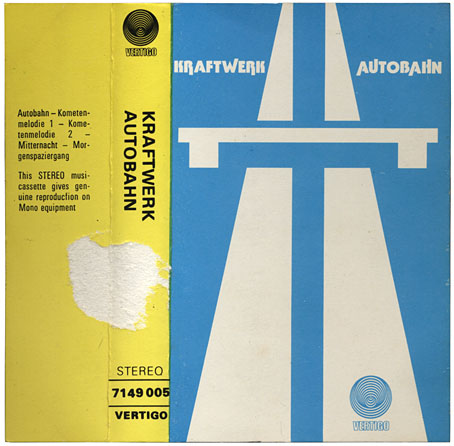
Clearing junk today turned up some obsolete artefacts one of which (the Kraftwerk) has been kept for purely sentimental reasons. It’s been amusing the past few years watching the vinyl disc refuse to crawl onto the scrapheap of history despite its death having been announced many times over by journalists who should know better. Several of the CD releases I’ve designed recently have also been brought out in vinyl editions. Meanwhile the audio cassette really is on the way out: “Sales of music cassettes in the U.S. dropped from 442 million in 1990 to about 700,000 in 2006” says Wikipedia. I certainly won’t mourn its passing; portability aside, I always hated these things. Music sounded shitty unless the tape was chrome or some other high-quality format, and whatever the quality they were all subject to mangling by cheap cassette players.
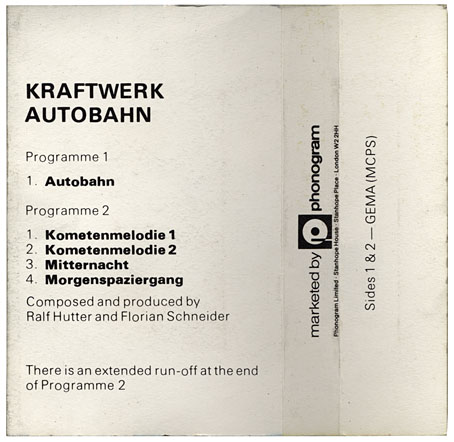
What struck me looking at the Kraftwerk cassette next to the BEF one (below) was the difference in presentation. The Kraftwerk release is a good example of perfunctory jobbing-out—the type inside looks like it was applied using Letraset—and as such is quite representative of the way record companies treated cassette releases. And the small size did nothing for the artwork, of course. I remember being transfixed when I saw the vinyl sleeve of Autobahn in a shop window. This was the first time an album cover struck me as being an arresting design rather than merely an interesting illustration. Subsequent releases reverted to a variation on the original German sleeve but the band seem recently to have accepted the traffic sign design as the ideal one.
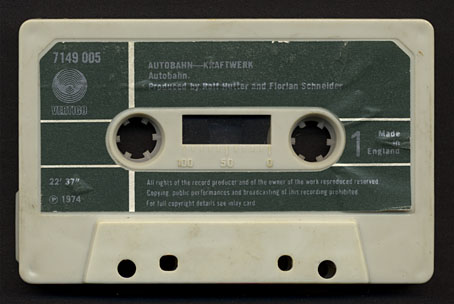
Music for Stowaways (1981) was the first release by BEF (British Electric Foundation), aka Ian Craig Marsh and Martyn Ware, post-Human League and pre-Heaven 17. Marsh & Ware were keen on the audio cassette as a future listening medium, especially in portable cassette players; “stowaway” was apparently a name (which I never heard anyone use) for what Sony called the Walkman. They intended this to be a cassette-only release although it did appear as a vinyl version entitled Music for Listening To.
In a rare reversal of the usual state of affairs, the packaging for the cassette was a considerably better than the vinyl edition. This is still one of the best cassette packages I’ve seen, hence the reason for keeping it. (Click on the images above for larger versions.) The design is credited to BEF with Bob Last.
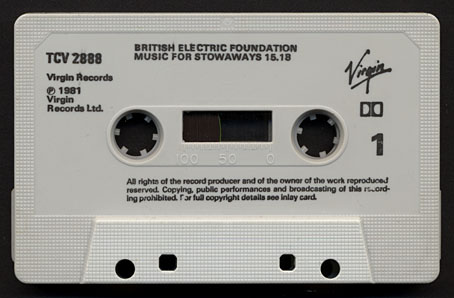
Printing on the plastic was a more durable solution than paper labels.
This short instrumental album, pitched musically between the Human League’s avant garde electro-pop and Heaven 17’s white funk (Groove Thang was (We Don’t Need This) Fascist Groove Thang minus vocals), remains a great collection of analogue electronica and, together with Heaven 17’s Temptation, I reckon it’s the best thing Marsh & Ware did. Anyone interested in the more intelligent music of this period should track down the CD which might lack the smart design but which does contain two extra tracks.
For more on the early Human League and Marsh & Ware’s projects, there’s the excellent Blind Youth site.
Elsewhere on { feuilleton }
• The album covers archive

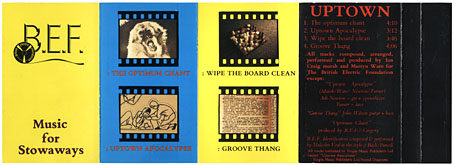
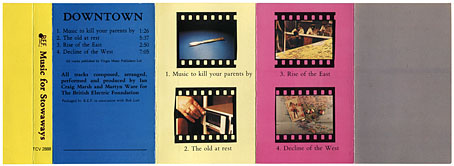
cassettes are still big outside europe and in developing countries etc, weirdly a new music shop opened up near me, in green lanes, it’s an albanian music shop and it sells mainly cassettes, as does the greek shop down on the lanes too, along side cds.
I’ve got trans europe express on cassette!
All the original electro hip hop compilations, came out with unmixed tracks on the cassettes, while for some reason, the more relevant i’d imagine vinyls were mixed, probably cos of ghetto blasters being the big thing at the time.
Oh, sure, and they still cling on in the audiobook world too. I might have mentioned extra tracks since I was forced to buy two albums on cassette for that reason. A Yello album and XL-1 by Pete Shelley, the latter being one of his (very good) forays into synth pop produced by Martin Rushent. The cassette featured some lengthy remixes, happily all available now on the CD.
Speaking of mixing, the main function of cassettes for me was in making compilations and crude mixtapes. Used to spend far too much time doing that.
I remember Factory records released a number of their catalogue (New Order, A Certain Ratio, Section 25, Durutti Column to name a few) in special cassette boxes about the size of VHS tapes. The cardboard boxes housed a plastic tray which contained the cassette and the album artwork was produced as an inlay, the size of the box and hence more acceptable than the normal microscopic cassette inlay. I am sure these boxes are now collectors items.
Can you believe I still have so,e K-7s which date back to the 70’s and they are still playing well?! Well, I guess I took good care of them, and I hope they still keep on playing firther, since some of them have different music and bands interspersed together.
And Kraftwerk, yes, I have some six or seven K-7s of them, all featuring live recorded material. I still like to hear them, now and then.
But electronic music took a great leap since the halcion days of Kraftwerk and, for me, Brian Eno is by far the most important name for such progress. Well, from the 70’s on of course, since we cannot forget Karlheinz Stockhausen, Edgar Varése, and the likes.
That’s it, my friend, all the best for you.
Hi Barrie: I remember those Factory boxes although I never bought any. This reminds me too that Industrial Records released a lot of exclusive stuff on cassette round about the same time, including every TG concert. I’ve just finished designing a book based on Rob Gretton’s notebooks when he was manager of Joy Division. More about that next week.
Márcio: I was in a computer shop today and noticed a USB cassette player which allows you to input tapes direct to your machine. And Kraftwerk rule, of course, but then I’m slightly biased.
On the subject of musical nostalgia, this might interest you if you haven’t seen it already: http://www.wildhunt.org/2008/10/music-is-still-magic-phonogram-returns.html
Hi Yvonne and thanks, I hadn’t seen that but then I don’t look at comics much any more. My loss, etc. Phonogram is a word you don’t hear much any more. Radiogram is a word you hear even less…
Why are you wasting time discussing obsolete music formats? Do any of your readers even know what a cassette tape or an 8-track is without the illustrations?
By the way, I always thought the B-side of the Kraftwerk vinyl was more inventive.
XL-1 by Pete Shelley, the latter being one of his (very good) forays into synth pop produced by Martin Rushent. The cassette featured some lengthy remixes, happily all available now on the CD.
hmm i remember the vinyl of this has the audio for a computer game on it, so you were meant to record the track to cassette and play it back into your spectrum to get a very very basic computer game.
quite a tasty idea.
Richard: A friend of mine collects 8-track cassettes. Or he did–you don’t see them around much any more.
MMS: Yes, both tape and vinyl of XL-1 included the Spectrum program and I had one of those computers as well so was able to get it working. For some reason the vinyl version worked (after being taped) yet the cassette version never did. The program didn’t do much apart from make some garish patterns and print out the lyrics in time to the music. Or almost in time…I could never synch the thing properly.
I remember the guy who made the program saying that Tony Wilson gave him the money to buy a Spectrum after they were talking about computers, so there’s another Factory link as well.
And here’s the program in question… Screenshots and other info. You can also download the code.